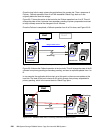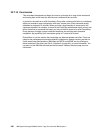
294 IBM System Storage DS6000 Series: Copy Services with IBM System z
Once the local site is ready, quiesce the application at the remote site. Then a sequence of
Failover - Failback operations from A to B will reestablish Global Copy back as it was
originally before the local site outage.
Figure 23-17 shows the action at the local site, the Failover operation from A to B. This will
change the state of the A volumes from secondary pending to primary suspended, and start
to keep a bitmap record of the changes to the A volumes.
Once the Failover is completed, a Failback operation from A to B is done; see Figure 23-18.
Figure 23-18 Failback from A to B and resync Global Copy volumes
Figure 23-18 shows the Failback operation at the local site. This will change the state of the B
volumes from primary pending to secondary pending, and start to replicate updates from A to
B.
In our example, the application did not start yet at this point, so there are no updates at the
local site. The state of the local volumes A will quickly change from primary suspended to
primary pending, which is the normal state for Global Copy pairs.
Figure 23-19 Establish Global Mirror FlashCopy relationship between B and C
Global Copy
Primary
Primary
A
Primary
Primary
A
Tertiary
C
Primary
Primary
A
Primary
Primary
A
B
Remote site
Host
Primary
Primary
A
Primary
Primary
A
A
Secondary
PENDING
Resync from A to B
Host
Primary
PENDING
Failback A to B
Local site
Global Copy
Primary
Primary
A
Primary
Primary
A
Tertiary
C
Primary
Primary
A
Primary
Primary
A
B
Remote site
Primary
Primary
A
Primary
Primary
A
A
Secondary
PENDING
Host
Primary
PENDING
FlashCopy
Local site


















